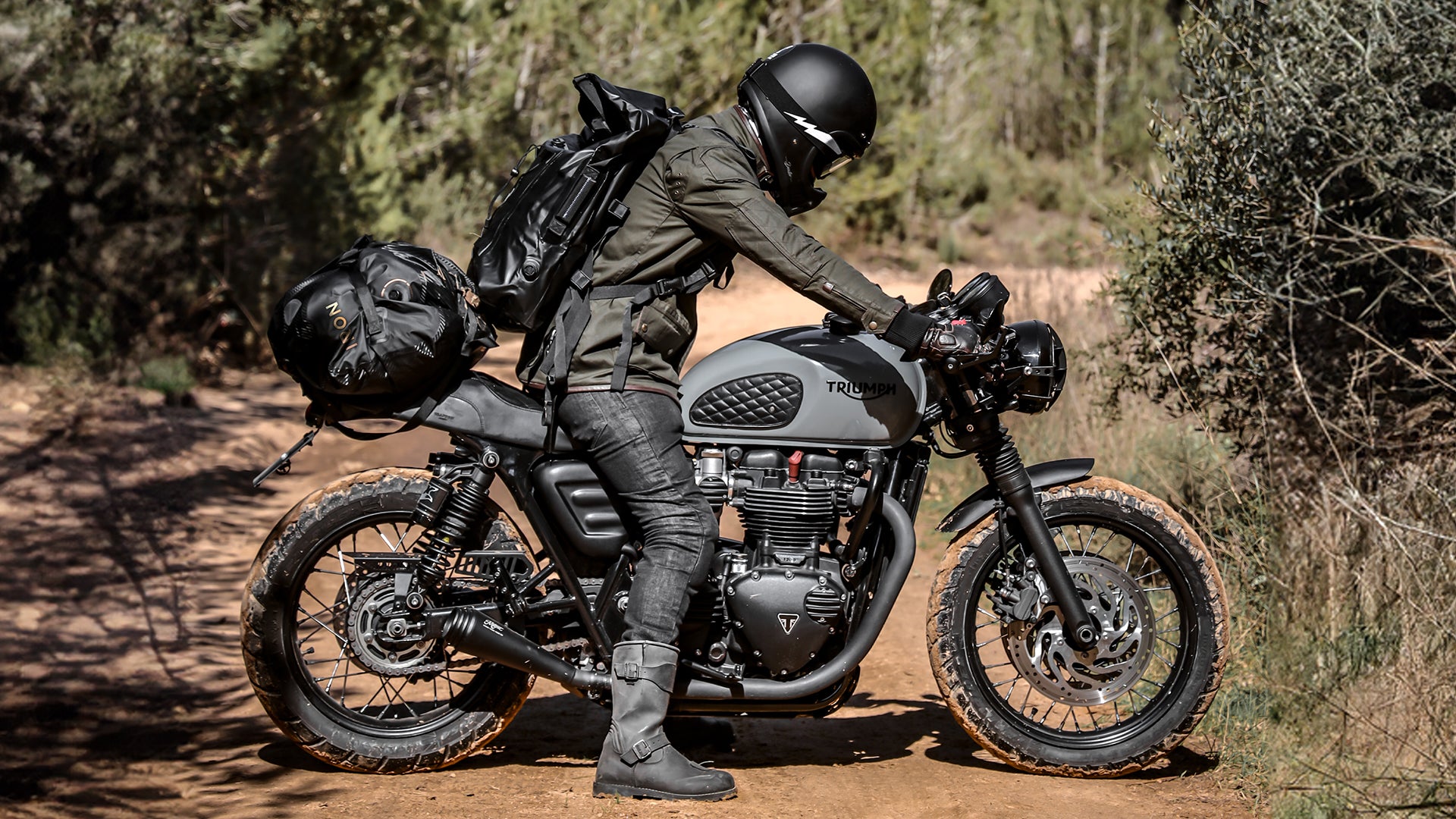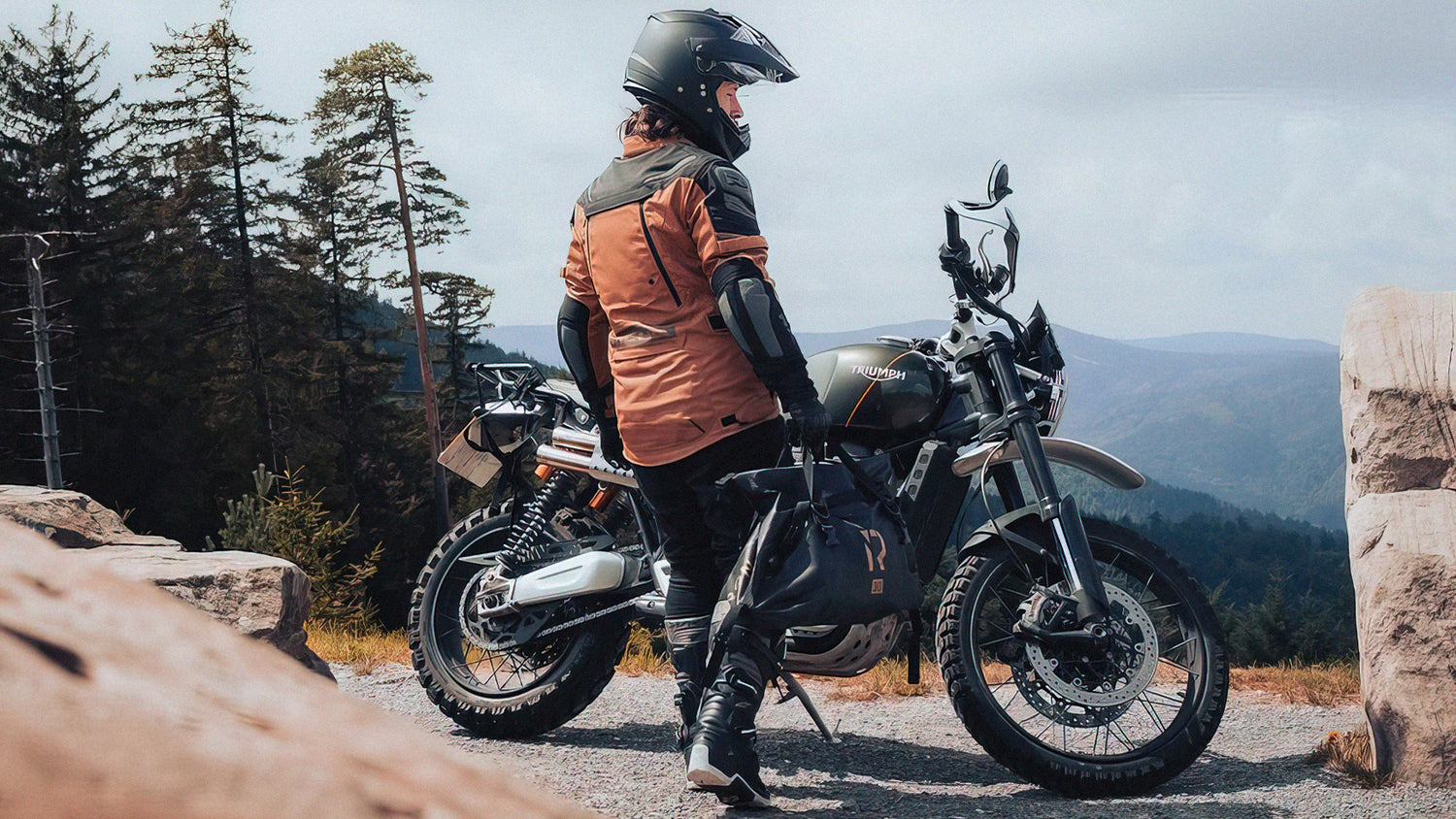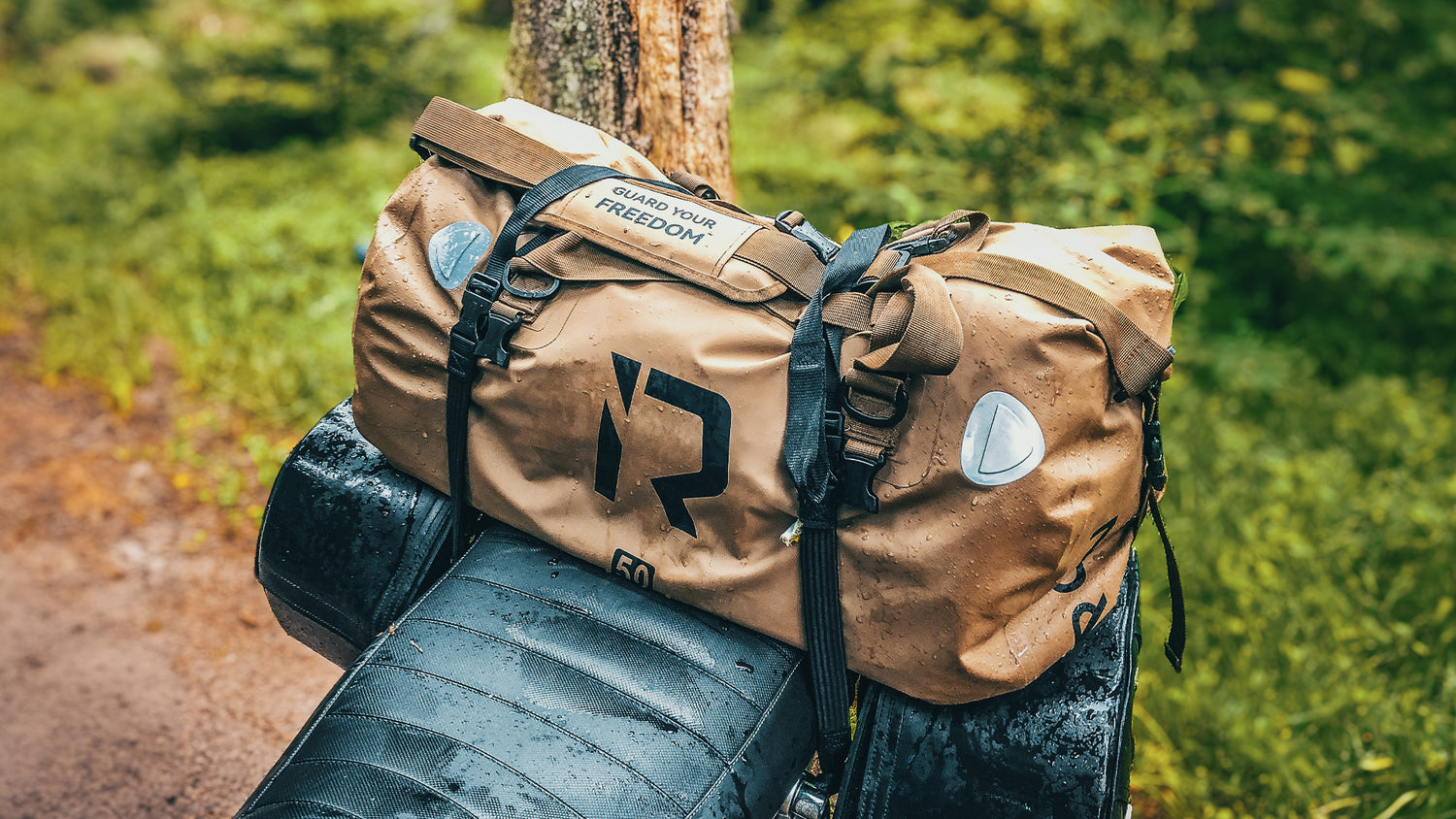While motorcycles are a thrill to ride, they don’t have much storage capacity. That’s where motorcycle bags come in. Motorcycle bags come in many different types like tank bags and tail bags. There are different mounting systems to consider and proper ways of packing your belongings to distribute weight. In this guide, we’ll cover the different types of motorcycle bags and what to keep in mind when shopping around.
Key Takeaways
- Different types of motorcycle bags include saddlebags, tank bags, tail bags, backpacks, panniers, and handlebar bags.
- Materials used for motorcycle bags range from leather and textile to hard cases made of aluminum or polycarbonate.
- Mounting systems vary from strap-on and magnetic to bolt-on options, each offering different levels of security and convenience.
Types of Motorcycle Bags
There’s a wide range of motorcycle bag options out there. We’ll cover some of the most popular options below.
Motorcycle Saddlebags
Saddlebags offer a classic look since they rest on either side of the tail. Depending on the brand, you can choose throw-over, bolt-on, hard, soft, and leather options. Each style offers unique benefits in terms of security, durability, and appearance.
Another perk of using saddlebags is they keep your center of gravity low. This means you don’t feel much of a difference in handling when turning (as long as you use two saddlebags, not just one).
Read more: Motorcycle Saddlebags
Motorcycle Tank Bags
Tank bags are good for stashing important items. Many bags feature quick release mount systems, so you can grab and go as soon as you park the bike.
The exact type of attachment systems vary, including magnetic, strap-mounted, and hybrid options. Tank bags are durable and weather-resistant, and some have integrations for mobile devices or hydration systems.
The positioning on the fuel tank allows for easy reach while operating the vehicle, making tank bags a popular choice.
Motorcycle Tail Bags
Tail bags offer more versatility and capacity than tank bags. They come in various dimensions and designs, often featuring expandable compartments to adapt for different needs. You can find hardshell and soft-sided tail bags of multiple sizes.
Many models incorporate weather-resistant fabrics and waterproof construction to shield contents from rain and road spray. Waterproofing can also seal out dust and debris.
Read more: Motorcycle Tail Bags
Motorcycle Backpacks
Motorcycle backpacks let you safely transport essentials while maintaining balance and control. Compared to a standard school or travel backpack, motorcycle backpacks are tougher and allow for better weight distribution.
Many models incorporate storage for hydration systems, electronic devices, and maintenance tools. Safety-conscious designs may include reflective materials or integrated protective armor, as well.
Read more: Motorcycle Backpacks
Panniers
Motorcycle panniers provide ample storage capacity while maintaining vehicle stability. These are mounted on racks on both sides of the rear wheel. They can usually handle larger loads than saddlebags which are secured over the top of the tail.
Panniers come in hard and soft variants, typically providing 25-50+ liters of storage per bag. Hard panniers offer great protection, waterproofing, and security, often incorporating locking mechanisms and reflective materials. In contrast, soft panniers offer flexibility and lighter weight. Long-distance riders often prefer panniers for securing luggage during extended trips.
Handlebar Bags
Motorcycle handlebar bags give you storage right on your bike's handlebars. These compact storage solutions offer quick access to essential items without affecting vehicle handling or stability.
Many models incorporate clear map compartments, reflective elements, and adjustable fasteners. With these bags, you have your important items within reach while maintaining your motorcycle's performance and style.
Compare Motorcycle Bag Types
Below is a quick comparison of popular motorcycle bag types.
|
Motorcycle Bag |
Definition |
Common Features |
Main Uses |
|
Saddlebag |
A bag attached to the rear sides of a motorcycle |
Spacious, durable, weather-resistant |
Touring, commuting |
|
Tank Bag |
A bag mounted on the fuel tank of a motorcycle |
Magnetic or strap mounting, accessible |
Adventure riding, daily use |
|
Tail Bag |
A bag attached to the rear seat or tail of a motorcycle |
Compact, expandable, detachable |
Sport riding, long trips |
|
Pannier |
A pair of bags mounted on either side of a motorcycle |
Balanced, large capacity, lockable |
Touring, long-distance travel |
|
Roll Bag |
A cylindrical bag often used on the rear seat or luggage rack |
Waterproof, versatile, durable |
Camping, touring |
|
Frame Bag |
A bag that fits within the frame of a motorcycle |
Lightweight, compact, easy access |
Off-road, adventure riding |
|
Handlebar Bag |
A small bag mounted on the handlebars of a motorcycle |
Compact, accessible, often waterproof |
Commuting, short trips |
|
Backpack |
A wearable bag designed for motorcyclists |
Ergonomic, secure, waterproof options |
Commuting, off-bike use |
|
Fanny Pack |
A small bag worn around the waist |
Convenient, lightweight, accessible |
Short rides, quick access items |
|
Tool Bag |
A small bag specifically designed to hold motorcycle tools |
Durable, organized, compact |
Maintenance, emergency repairs |
What Are Motorcycle Bags Made Of?
Popular materials for motorcycle travel bags include leather, textile, and hard cases.
Leather
Leather motorcycle bags offer superior durability, style, and weather resistance. These premium accessories typically feature leather thicknesses ranging from 1.2mm to 2.0mm, with thicker options providing more longevity.
Leather is great because it naturally resists wear and tear. That said, you should condition leather regularly to prevent cracking and fading. You might also want to use additional waterproof covers when exposed to extended periods of rain.
Textile/Cloth
Soft-sided bags are great for reducing weight and saving some money. Manufacturers use materials like nylon, polyester, and canvas. These durable materials help bags endure riding conditions while offering generous cargo space.
Manufacturers can also apply protective coatings and use high-denier fabrics to make the bag stronger. Reinforced construction like strengthened seams and stitching also improve overall durability. Since these bags are pliable, you can roll them up and store them easily when you don’t need them.
Hard Cases
Hard cases offer the ultimate protection. These luggage systems use materials like aluminum, polycarbonate, and ABS plastic.
Aluminum cases are great for strength and corrosion resistance. They’re useful for long road trips and off-road adventures. Polycarbonate options offer a lightweight alternative with good impact resistance.
You can find bags that have double-walled construction, too, which improves insulation and security. Keep in mind the material's weight when selecting a hard case luggage system, since multiple bags can add a good amount of weight.
Mounting Systems for Motorcycle Bags
You have many options for different ways to install a motorcycle bag. If you want to take the bag and go in a hurry, consider strap-on or magnetic options. On the other hand, bolt-on luggage offers good security and minimizes the chance of a bag shifting during a ride.
- Strap-on: These mounting systems employ flexible materials and fastening mechanisms, often incorporating quick-release features for convenient removal.
- Magnetic: Tank bags equipped with powerful magnets adhere directly to metal fuel tanks, creating a low-profile design that minimizes wind resistance and enhances aerodynamics.
- Bolt-on: Bolt-on systems use specialized hardware to attach directly to the bike's chassis, ensuring exceptional stability during rides.
What Features To Look For
Not all bags offer the same features. Depending on your riding style and climate, you might need a waterproof bag or one that offers a lockable compartment.
- Waterproofing: Waterproof motorcycle bags keep out rain, snow, dust, and debris with impermeable seams and heavy-duty construction.
- Expandability: Expandability in motorcycle bags provides you with adaptable storage solutions. Gear capacity can be adjusted on-the-go, accommodating varying equipment needs for different journey types.
- Security: Anti-theft motorcycle luggage is essential for protecting your belongings during travel. Secure zippers, durable construction, and integrated locks protect against forced entry.
How Much Do Motorcycle Bags Cost?
Motorcycle bags come in a range of price options. You can find affordable bags for around €30 for soft construction and €50 for hard construction. Of course, it also depends on what type of bag you want to get. Choosing a simple handlebar, tank, or tail bags can keep costs low.
If you want thick full-grain leather, be prepared to spend over €100. High-security hardshell bags also start around this range.
Moving up, you’ll pay €500 or more if you want a set of hardshell panniers or saddlebags that are custom to your motorcycle brand. These options will fit perfectly with your bike’s style.
What To Consider Before Buying a Motorcycle Bag
Before you jump in and buy a bag, consider a few things like the bag’s capacity and compatibility.
Capacity
The best motorcycle bag depends on how much you need to pack. Touring enthusiasts should use bags of at least 40L for extended trips, while smaller capacities are OK for brief outings.
If you’re into adventure motorcycling, you might want a bigger bag. One over 50L can do the trick to accommodate camping equipment and outdoor gear. Weight distribution is also important. Pack heavier items lower in the bags to keep a solid center of gravity.
Compatibility
Many motorcycle bags have universal mounting systems, but that's not always the case. You’ll have to make sure the bag fits your motorcycle's frame without interfering with existing accessories.
There are a few more things to think about. For example, if you have an aftermarket exhaust, it might affect the way a saddlebag sits on the bike compared to a stock exhaust. Also, certain bags can reduce the amount of room you have for passengers or make it hard for them to reach the pegs.
Motorcycle Bags: Conclusion
By now you can see you have many types of motorcycle bags to choose from. Whether a tank bag or a saddlebag is more your style is up to you, but be sure to shop from reliable companies that offer motorcycle-specific gear.
Motorcycle Bag Options: FAQ
Below are a few frequently asked questions about motorcycle bags.
How do motorcycle bags affect fuel efficiency and mileage?
Motorcycle bags can impact your fuel efficiency and mileage. They'll increase wind resistance, affecting aerodynamics. Heavier loads require more power, consuming extra fuel. Streamlined, lightweight bags positioned correctly will minimize these effects, helping maintain peak performance during your rides.
Can motorcycle bags be used as everyday carry bags off the bike?
Many motorcycle bags adaptable for everyday use. They're often durable, weatherproof, and feature practical designs. However, you'll need to contemplate their size, weight, and specialized mounting hardware when deciding on off-bike versatility.
Are there specific motorcycle bags designed for extreme weather conditions?
Yes, there are specialized motorcycle bags designed for extreme weather. Waterproof dry bags, heat-resistant panniers, and cold-resistant tank bags featuring advanced materials like TPU-coated nylon, Cordura, and thermal-insulated linings to protect your gear in harsh conditions.
What's the impact of motorcycle bags on handling at high speeds?
You'll notice aerodynamic changes with bags at high speeds. Larger, improperly secured luggage can cause instability, buffeting, and increased wind resistance. Streamlined, well-balanced bags minimize these effects, maintaining your bike's handling characteristics and fuel efficiency.





